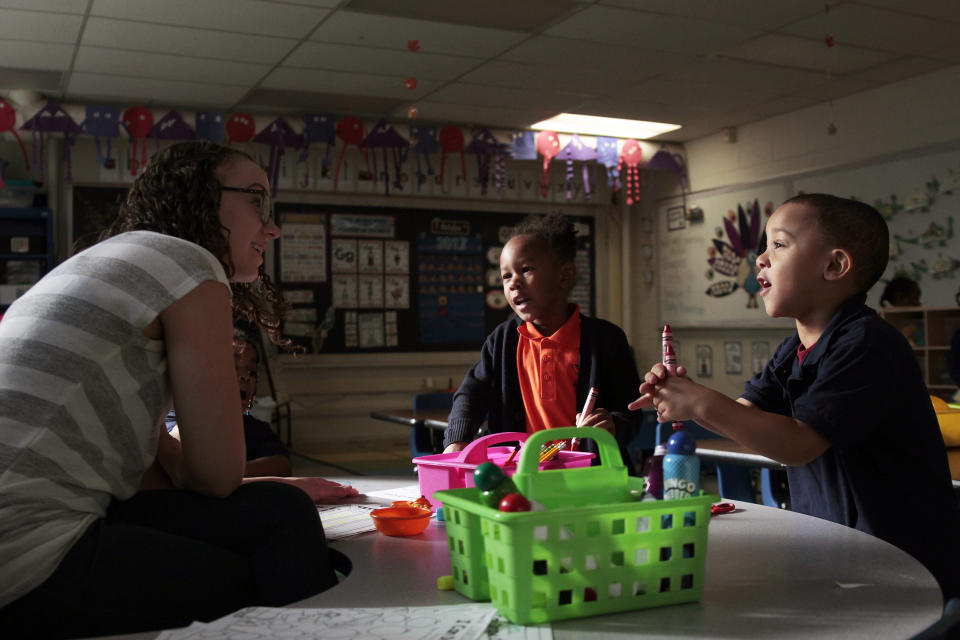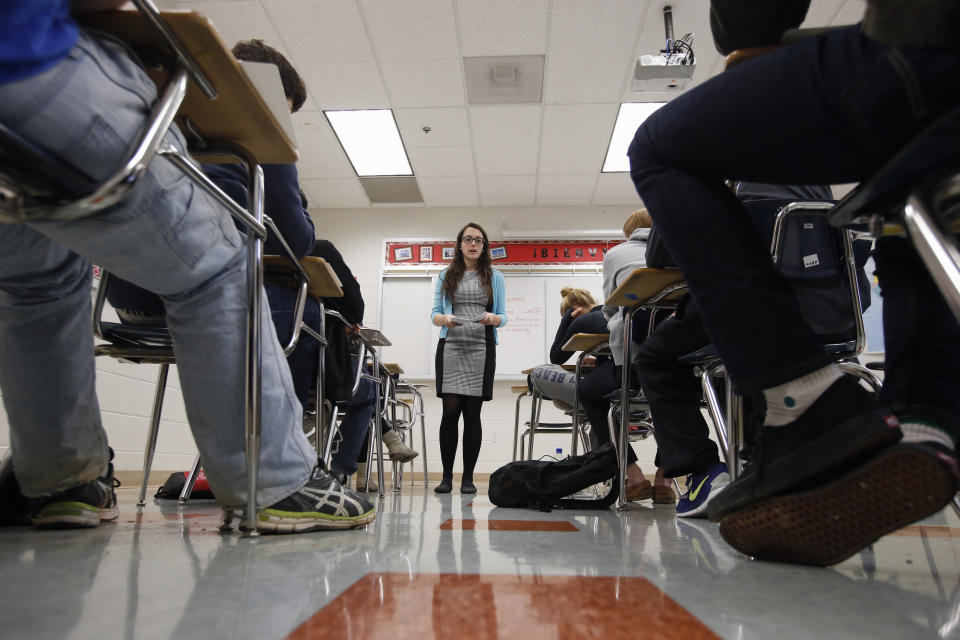America’s true education scandal: poor, minority children continue to be left behind in public schools

Recently, the news has been full of headlines on the disparities that exist in the American education system. Some wealthy parents — including actresses Lori Loughlin and Felicity Huffman — have been indicted for gaming the admissions process for their children to some of the nation’s top colleges. Last week, Loughlin pleaded not guilty to charges of conspiracy to commit fraud and money laundering. Meanwhile in New York City, only 7 black students were admitted to the city’s most selective public high school — out of 895 spots. Currently, Harvard University is being sued over its affirmative action admissions policies.
The beleaguered American education system has struggled for years to address issues of inequality, with little success. A new report from the education research and advocacy group EdBuild finds that there is a $23 billion gap in funding between white and non-white school districts of equal size (the report identifies white school districts as those with 75% or more white students).
“What’s happening here is you are seeing a continuation of what we’ve found in previous reports: the foundation of the education funding system does not serve to best represent the interests of students from socioeconomically disadvantaged backgrounds,” said Matt Richmond, chief program officer at EdBuild.
The wealth gap
But even when EdBuild looked at districts of similar wealth levels, it found there were big differences that cleaved along racial and ethnic lines, with minorities receiving less than their white counterparts.
“In the U.S., race and economics tend to be correlated,” he said. “What was even more disappointing was that even when you accounted for poverty, there was still a difference of about $1,500 per student, even in high poverty school districts.”
The problem, the report points out, is the way public schools are funded. According to Richmond, 45% of funding comes from local sources, while 45% is provided by the state. The final 10% is made up of federal government funding.
With school budgets tied to the local tax base, wealthier communities are able to provide more funding for their local school districts.
“In a way, that’s systemic and formulaic,” Richmond said. And the wealth gap between communities is too large for the states to bridge, he said.
“If you look at the distribution [from states],” Richmond continued, “for the most part you find it’s relatively progressive. More money is going to districts with less wealth. You do see the states trying. But they have a tendency to fall short.”
But according to a 2018 report from the Rutgers Graduate School of Education and the Education Law Center, school funding isn’t as progressive as it needs to be. The report shows that funding disparities between states isn’t shrinking, but instead growing. “The funding differential between the highest (New York) and lowest (Idaho) funded states is over $12,400,” the report states.
The report goes on to say many states are becoming more “unfair” in their funding. “In 2015, only 11 states had progressive funding systems, down from a high of 22 in 2008,” the report says.
These gaps disadvantage already disadvantaged children.

Children from lower-income communities are less likely to be enrolled in earlier education, while teacher salaries — already lower than their non-teacher counterparts — are more competitive in states and districts with more funding, attracting higher-quality teachers. But according to the report, one of the most “meaningful” outcomes of fair funding is student-teacher classroom ratios.
And that’s not all. The Washington, D.C.-based think tank Urban Institute has found that children “from high-wealth families (defined as total family wealth including home equity above roughly $223,500) are more than one and a half times as likely to complete at least two or four years of college by age 25 as those in low-wealth families (wealth below $2,000).” And once they make it into college, children from high-wealth families are nearly twice as likely to graduate from a four-year institution — compared to less than a quarter of students from low-income households.
Segregation and secession
But education inequality isn’t only driven by large wealth disparities in the tax base. Segregation is another factor. Five years ago, on the anniversary of Brown v. Board of Education, UCLA’s Civil Rights project published a report that found segregation had gotten no better since integration in 1967. Others argue that school segregation has actually gotten worse.
An analysis in The Atlantic shows that the number of segregated schools has doubled between 1996 and 2016, a time when the number of minority children attending those schools rose from 59% to 66%.
“Segregation by race and by income have indeed gotten worse over time,” said Emma Garcia, an economist at the Economic Policy Institute. “Some may argue that the demographics of the student population changed over time too, but the reality is that schools don’t reflect the diversity of the country — they reflect a system that does not offer equal opportunities to all students depending on their race, origin, or socioeconomic status.”
Garcia, whose research focus is on the economics of education, has studied the damaging effects of segregation on students. In a 2017 report, Garcia found that segregation harms children of color more than their white counterparts.
Her study also found that “a much higher fraction of black and Hispanic students attend high-poverty schools than white or Asian students,” and that black and Hispanic students were more likely to attend high-poverty schools — even when they were not poor.
Evaluating testing scores, the report found that children of color performed worse than their white counterparts. And, the study shows, “as was the case with race/ethnicity, students’ poverty status was closely associated with their academic achievement. When race/ethnicity and poverty are combined, the effect is enormous.”
But local communities don’t just struggle with segregated school districts. Some communities also choose to “secede” from their school district and form another — taking their tax dollars (and therefore their wealth) with them.
“It’s not something that people have paid close attention to,” said Richmond. “But it is continuing today, and it is a concerning trend.”
The myth of meritocracy
To combat this, schools have tried to reward students based on “merit” and not accident of birth (defined as the desirable or undesirable circumstances of one’s birth or parentage). In New York City, a written exam is the only requirement for admission to highly selective public high schools.
But is meritocracy fair? And does it work? With only 7 black students picked for 895 slots, critics of the system say no.
“A lot of our research shows that some students’ characteristics — mainly parents’ economic and social capital — matter more than their own effort and abilities,” Garcia said.
“What does merit mean?” Richmond asked. “A test? A portfolio system where the things that count are things that cost money and time?”
Critics argue that children from higher-income households have the opportunity to access tutors, admissions test prep, and the benefit of better education to help them appear more attractive in selective admissions processes. Many call meritocracy a myth.

The myth came under fire again as wealthy parents were indicted for paying for their children to get into top-tier universities like Yale, Stanford, and University of Southern California (USC).
For Richmond, the scandal, dubbed Operation Varsity Blues, highlighted the illegal and legal ways that children of privilege can rig the system in their favor.
And with the federal government looking to make 12% cuts to the Department of Education, both Richmond and Garcia are concerned.
“Not all states have recovered pre-recession per-pupil spending levels,” Garcia said. “Further cutting to spending does not seem to help with that, and cutting spending per se would also be counterproductive given other trends, such as the increased inequality, etc., that would require added supports, not fewer money.”
Richmond agrees, but argues that education is in the purview of the states, not the federal government. Any federal money should supplement — not supplant — local dollars, he said.
“But it is concerning that there is less money going to school districts of incredible need,” he added.
So how then to level the playing field?
Making funding equal
Richmond says that one piece is about addressing issues with funding — which would mean making changes to tax bases.
“You’ll never be able to convince people to not do the best for their children,” Richmond said. “You need to try to expand school district boundaries to encompass more communities. If you can create regional tax bases to a higher administrative unit and then redistribute, that would also work. The ultimate conclusion would be to have a state-driven education funding system.”
But funding fixes won’t solve the entire problem. It’s imperative to address issues of housing, wealth inequalities, and racial segregation, say experts. And if it doesn’t happen, the number disadvantaged students left languishing in America’s education system will continue to rise.
Kristin Myers is a reporter at Yahoo Finance. Follow her on Twitter.
Read more:
Follow Yahoo Finance on Twitter, Facebook, Instagram, Flipboard, SmartNews, LinkedIn,YouTube, and reddit.

 Yahoo Finance
Yahoo Finance 
